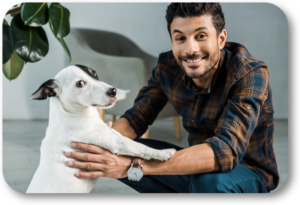I was over in Canton last week at a new Home Dog Training Client working with him and his Jack Russell named Willie. The big problem that he had with Willie was that he pulled on the walk and loved to jump on people. We quickly corrected the jumping and Willie started to walk much better after I took him and my client for a walk around the block. My client was amazed at the results and told me he was going to tell all his neighbors about Willie’s extraordinary transformation into a great dog.

As we were finishing up, I asked my client if he could think of anything else we needed to accomplish while I was there. He thought for a moment and then, a light bulb went off in his head. “When I get home at night, Willie is right there on the other side of the front door. I walk in and he jumps and barks. I pet him but he won’t stop. How do I tell him to cool it?”
First of all, I told him that with the instruction we had provided him and Willie that day, he would be able to easily resolve that annoying behavior. I told him that it is natural that after a long day at work where we are probably screamed at by our boss or had a customer demand a refund, or just had a stressful day, it is always great to come home to our dog who is really excited to see us. We immediately respond to our dog’s request for attention. We normally pet him or hug him and then “try” to walk in the house to chill out.
The problem is that our dog just doesn’t want to stop asking for “hugs and attention”. It finally gets to the point of just becoming annoying. We then get mad. The last thing we wanted to do was to come home and be mad at our dog…
The first thing we tell our clients in a situation such as this is that they need to understand that their dog needs to “be treated like a dog”. Their dog perceives the family as his pack. In a pack, there is the leader and the followers. The leader makes all the decisions for the pack. Everything must be his idea. The pack will wait to be directed and commanded by the leader.
So, when my client comes home and opens that door, Willie is coming up to engage and set his role as the leader. Since my client is a human and doesn’t follow the same social norm, he thinks nothing of his dog’s request for attention and complies. He has just allowed Willie to tell him what he wants my client to do. My client (unknowingly) passively accepts that Willie is the leader and he will do whatever Willie wants. That is why my client’s dog won’t leave him alone. He has more stuff for my client to do.
The solution to this issue requires my client to assert passive dominance. When my client comes home and opens the door, he needs to ignore Willie completely. If Willie starts to become annoying, he needs to correct Willie and continue into the house on his terms. He should be slow, calm, and resolute in his actions. Remember, he needs to assert that he is the leader and the one making the rules. Willie is simply “the follower” and must follow the direction of my client (the leader).
My client needs to enter the house and perform any action of his own choosing. It doesn’t matter what that action may be. He may simply put his keys on the table, take off his coat, or get a cold drink from the refrigerator. The important thing is that the action is easily discernable to Willie and freely implemented by my client. This is sending a clear signal to Willie that my client is doing what he wants and is not engaging him in any way. It is reinforcing his leadership role with Willie in a way Willie naturally understands. It is also keeping the entire situation calm and in my client’s control.
When my client is finished “doing his action”, he should calmly call Willie to him. He can now pet him and greet Willie. The major difference between this way and Willie’s way is that everything is now on my client’s terms. Willie is now acting on what my client wants him to do. In this situation, Willie is now identifying my client as the leader and Willie is accepting his role as the follower.
I told my client to try this out and assured him that he would see a remarkable difference in Willie and he will have a very pleasurable homecoming after a long, hard day at work.
Please call Robin or me at (770) 718-7704 if you need any dog training help. We are blessed to have been your local dog training professionals for over sixteen years. We have trained over 5,000 great dogs and loving families and are ready to help you.

Follow Us!